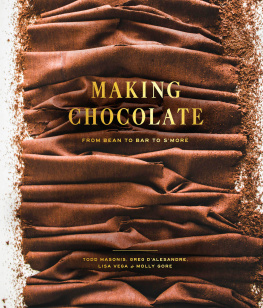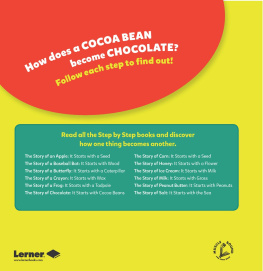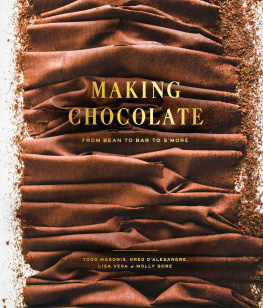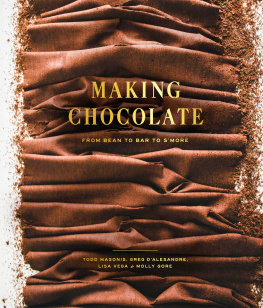GLOSSARY
BLOOM: The surface expression of untempered chocolate after sitting for a period of time, of which there are two types: fat bloom and sugar bloom. Because the crystal structure of untempered chocolate is unstable, the sugar and fat particles are free to migrate within the chocolate, appearing on the surface as dusty white splotches, streaks, or patches of sugar crystals.
CACAO: According to most dictionaries, cacao and cocoa are interchangeable. People usually use the word cocoa to refer to cocoa powder or cocoa beans (usually after they have been fermented and roasted) and cacao to refer to the agricultural product. We use the distinction that cacao is a living plant, and cocoa is a dead product.
CACAO FARMER / PRODUCER: We use the term cacao farmer to refer to someone who is involved in the agricultural production of cacao, including planting, growing, and harvesting. Cacao farmers often ferment and dry their own beans, but we would not refer to someone as a cacao farmer if he or she solely processed (including fermenting and drying) and handled beans from someone else; wed call that person a producer. All cacao farmers are producers, but not all producers are cacao farmers.
CHOCOLATE MAKER: A person who creates chocolate from raw ingredients (cocoa beans or liquor, sugar, cocoa butter, and other additives).
CHOCOLATIER: A person who uses prepared chocolate to create confections, bonbons, and treats.
COCOA BEAN: The bitter, purplish seed of the Theobroma cacao tree. To make chocolate, the seeds are extracted from the cacao pod after harvest, then fermented and dried before they undergo a chocolate-making process.
COCOA BUTTER: The creamy white or light yellow, mildly flavored fat that is naturally present in a cocoa bean. Cocoa beans are usually a little more than 50% fat, depending on where they grow; generally speaking, the farther from the equator they are, the higher the fat content. Some chocolate makers add additional cocoa butter to their chocolate for richness or to decrease the viscosity and make it easier to work with.
COCOA LIQUOR: The thick, sludgy liquid produced when nibs are crushed finely enough to release the fat inside their cells.
CACAO POD (OR COCOA POD): The elliptical, ribbed fruit that grows from the trunk of the Theobroma cacao tree. Inside the pod are about forty seeds (cocoa beans), connected by a fibrous ribbon called a placenta, and surrounded by a sweet white pulp called baba.
COLLOID: Dissimilar microscopic materials mixed together in a homogenous system. Typically, particles in a colloid will be less than one micron (smaller than the solid particles in chocolate), but we think its close enough to consider chocolate a colloid. A sol (like chocolate) is a subcategory of colloid.
CONCH (VERB): The process of mixing, oxidizing, and shaping the particles within chocolate to control flavor and texture. This is typically done in a machine that scrapes, mixes, and exposes the chocolate to airflow.
CONCHE (NOUN): A machine that scrapes, agitates, and mixes chocolate.
CRACKING: The process of breaking the whole cocoa bean into shards of husk and nib, usually to prepare the beans for winnowing.
EMULSIFIER: A substance that stabilizes the suspension of two nonsoluble liquids and keeps them from separating.
EMULSION: An emulsion is formed by blending two insoluble liquids together into a homogenous solution. An emulsion is a type of colloid. Chocolate is not technically an emulsion because it is made of solid particles suspended in liquid, not a liquid in a liquid. Even so, it does act like one.
FERMENTARY: The location or facility where cocoa beans are fermented.
FERMENTATION: In reference to cocoa beans, fermentation is the process of transforming the compounds within the seeds by gathering freshly harvested seeds together, usually in a wooden box that may be lined or covered with banana leaves, typically for somewhere between three and seven days. During this time, bacteria and yeast transform the sugars in the pulp surrounding the seed into acids that change the compounds inside the seed, establishing the precursors to chocolate flavor as we know it. Fermentation has a substantial impact on the final flavor of a cocoa bean.
HUSK: The fibrous outer shell of the cocoa bean that protects the nib inside. To make chocolate, the husk is removed from the nib before the nibs are ground.
MELANGER: A type of mechanical grinder outfitted with two stone wheels and a circular stone base inside of a steel drum. Originally designed for refining batter for Indian lentil pancakes, a melanger can grind wet or dry matter. It is used in chocolate making to refine nibs and other ingredients by crushing them between the wheels and base. A smaller adaptation of a melanger designed for home use is what we call a mini melanger.
NIB: The inside of a cocoa bean, without its husk. To make chocolate, the nibs are typically roasted, separated from the shell, and crushed (usually with other ingredients like sugar). The nib is comprised of cocoa solids and cocoa butter.
REFINE: In reference to chocolate making, refining is the act of crushing cocoa nibs with sugar (and other ingredients) to create chocolate. This can be done in a variety of machines, but the basic process involves smashing the nibs and sugar into smaller and smaller particles, depending on the level of smoothness the chocolate maker is seeking.
ROAST PROFILE: The time and temperature at which a set of cocoa beans is roasted to bring out a desired set of flavors.
SOL: Solid, microscopic particles in a homogenous liquid solution. Chocolate is a sol.
TEMPERING: The process of heating and cooling chocolate to specific temperatures in order to control the shine, snap, and melting point of the solidified chocolate.
VISCOSITY: A measure of the thickness and flow of a liquid, which depends on internal friction. Chocolate with a proportionally high ratio of fat to solids will be less viscous than a chocolate with less fat, because the fat lubricates the space between the cocoa solids, reducing the friction. Highly viscous chocolate can be difficult to temper and work with.
WINNOW: To separate the husk from the nib, usually by introducing a stream of air (from a hair dryer, a vacuum, a nice breezeyou name it).
RESOURCES
SOME GREAT CHOCOLATE SHOPS
Its such an exciting time for chocolate, and we encourage you to try all different makers and styles to find out for yourself what you like. The Internet is a great place to find chocolate bars, but we recommend stopping by a local retailer who specializes in craft chocolate. Here are a few of our favorites, and this list is growing all the time.
FARMSHOP , Los Angeles, CA
THE CHOCOLATE GARAGE , Palo Alto, CA
BI-RITE MARKET , San Francisco, CA
CHOCOLATE COVERED , San Francisco, CA
FOG CITY NEWS , San Francisco, CA
CHOCOLATE MAYA , Santa Barbara, CA
ZINGERMANS , Ann Arbor, MI
FRENCH BROAD CHOCOLATE LOUNGE , Asheville, NC
ABC CARPET & HOME , New York City, NY
THE MEADOW , New York City, NY, & Portland, OR
2BEANS , New York City, NY
CACAO , Portland, OR
CHOCOPOLIS , Seattle, WA
SOME GREAT RESOURCES FOR COCOA BEANS
(Hi, this is Francis, the editor of this book, and I just want to say that Greg and the Dandelion team were apprehensive about putting this list in the book, because the world is an uncertain place and some of this info might be dated by the time you are reading this. But they were kind enough to supply it, anyway. Just know that this was all accurate in the spring of 2017.)
Next page








